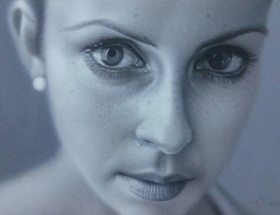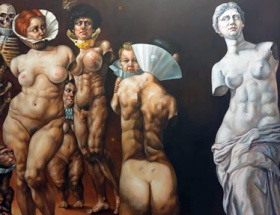From the Cavern of the Meninas
Por Antonio Correa Iglesias
“Any art originates from an exceptional lack.”
Teoría de la retaguardia, Iván de la Nuez
I
With Plato and his eidetic world, and with Aristotle and his substantial universe begin our understanding and misunderstandings in Western culture. Even more, Parmenides is one of those essentials responsible –there is always more than one– once he establishes an understanding as doxy and as episteme. But it must also be said that this margin that goes from the cavern to the fronesis(1) has been the base of what Roger Shattuck has called “forbidden knowledge.(2)”
Neither is it a coincidence that Michael Foucault begins his treaty on the archaeology of knowledge(3) with a detailed analysis of Diego Velázquez’s painting “Las Meninas”, a sort of threshold where “two incompatible visibilities” come together, as he himself defined it.
The problem of the representation –what is represented when there is representation?– has been the foundational base of the entire Western thought as syllogism, induction and enthymeme(4), but even more: it has also been the base regarding madness and imagination. Gombrich, in “Art and Illusion: A Study in the Psychology of Pictorial Representation”, dissolves the argumentation of the myth of the “innocent eye, the idea that the artist looks at the world and transcribes what he sees as best he can.” This argument had been anticipated in “Meditations on a Hobby Horse”, a sort of research of the biological grounds of representation. I insist in all this since, at conceptual and visual level, the problem of representation continues to be a strong element of the production of images. As Gombrich well says, the representation was not, as one thought, an imitation of the visual appearance, but a substitute of something that one wished. In this way, the limits of the language, whichever they may be, are the limits of the representation.
 To the problem of representation adds the fact that today much is said about the rhythm from which these images are produced. Rhythm in that case is an essential element, because it will mark the difference among creation, programming, and reiteration in the creation of the image.
To the problem of representation adds the fact that today much is said about the rhythm from which these images are produced. Rhythm in that case is an essential element, because it will mark the difference among creation, programming, and reiteration in the creation of the image.
A problem that is totally unconnected to the whole theorization around representation. Something that Joan Fontcuberta has called “new visual order(5).”
II
David Salle in “Houdini with a Brush” states: “A good painting focuses our attention in a matter of seconds —what is sometimes called wall power— and it also holds our gaze over time. It repays prolonged looking. A good painting appeals to both the eye and the mind, the one refreshing the other. There is no one thing or set of things that a painting must do. A good painting can look like anything at all, or like nothing we’ve seen before.”(6)
When –coffee in hand– I finished reading this text, I knew that its argumentation contained everything I would need to think the work of Sandra & Emmanuel.
The work of Sandra and Emmanuel is a sort of old-fashioned hyper- realism –many times best solved with photography– and a “playful” effort of representation. The symbolical effectiveness that results from this relation places the work of these artists in a poetic ubiquity that becomes complementary in an apparent opposition. Eros and Thanatos, order and chaos, doctrine and epistemics, verse and reverse, sonority and sound of the Taoists. This ubiquity, shown through the work of Sandra and Emmanuel, is a “hindrance” derived from a post-revolutionary romanticism that, far from being an immaterial element that obstructs the action, boosts it once it focuses on the human figure lacking any political ideology; the human being as such, with his weaknesses and desires. The painting subjects in his work are halfway in the representation, trying to find themselves in an existential dimension.
The poetic force of his images not only lies in the hyper-realistic composition but in the balance supposed to be produced by a veil –like Maya’s– that covers the entire canvas surface, dissipating at intervals the composition; superimposition of realities, one static and the other dynamic, that in their own versatility compose a figuration. As in Escher’s paintings, where it is not clear which hand paints the hand, in the work of Sandra & Emmanuel a charming ubiquity establishes a recursive and complementary visuality.
With a solid education in painting, Sandra and Emmanuel –like the classics– carry out a search for the human figure. Not only the ontological meaning is evident in their production, but also the strong autobiographical vocation regarding refractory visuality, once7 they try to find in the symbolical search what –gone astray– was the organizational element of their existence.
The search for the human figure grants force and an anthropological and psychological character to the production of these young creators. This character is not a “mere” reference, but comes to reinforce what Geertz & Clifford called “poetic turn” in “Post- modern Anthropology”.
 The search for the human figure leads Sandra & Emmanuel to a dismounting of a visual hegemony. The “dismantling” of the iconographic solemnity in their work is solved through the introduction of juxtaposed planes, creating the fascinating illusion of movement. Parallel planes that complement each other to create visuality. The figurative nature of these works breaks the squaring of experience –base of the entire representation theory– and introduces in painting not the sign of the representation but the infinite possibility to search into the nature of the perception, hence the force of the sensorial element in his painting.
The search for the human figure leads Sandra & Emmanuel to a dismounting of a visual hegemony. The “dismantling” of the iconographic solemnity in their work is solved through the introduction of juxtaposed planes, creating the fascinating illusion of movement. Parallel planes that complement each other to create visuality. The figurative nature of these works breaks the squaring of experience –base of the entire representation theory– and introduces in painting not the sign of the representation but the infinite possibility to search into the nature of the perception, hence the force of the sensorial element in his painting.
But it is a profound melancholy what draws together his work. Concealed in the beauty of their characters –his own heteronyms– is a profound restlessness, as if they were waiting for something, as if something to come would gain a threatening dimension expressed in the whisper of a confession. Without remorse, Sandra & Emmanuel gather an existential impulse from a consistent, symbolical vocation. Astonished, they look at us as if questioning us for the meaning of existence, discovering themselves hand-tied and, disconcerted, absorbing the shadows projected on a cavern wall.
1. Distinction and delimitation in the world of sciences in Aristotle.
2. For further details, see: “Forbidden Knowledge: from Prometheus to Pornography”.
3. See: “Las palabras y las cosas: arqueología del saber”.
4. For further details, see: “Madness and Civilization: A History of Insanity in the Age of Reason” M. Foucault, p. 95.
5. For further details, see: Joan Fontcuberta “La furia de las imágenes”, 2016.
6. See “Houdini with a Brush” in The New York Review of Books, May 9, 2019 • Volume
7. “Tyler believes that anthropology is taking a poetic turn in the world of post-modernity (…) a growing interest toward the work, the forms of the discourse and the rhetoric. This anthropology would be a relativist one, but in a new sense: it denies that the discourse of a cultural tradition may comprise the discourse of another cultural tradition.”






